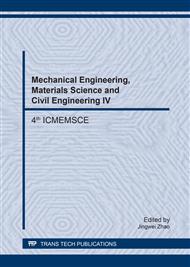[1]
Y. Yu and Y. Zhang, Controlled Synthesis, Dye-fixing Performance and Dye-fixing Mechanisms on Cotton Fabric of Novel Reactive Cationic Copolymers of N, N-Diallyl-3-hydroxy-azetidinium Chloride and Dimethyldiallylammonium Chloride (P (DHAC-DMDAAC) s). Australian Journal of Chemistry. 65(2012).
DOI: 10.1071/ch11481
Google Scholar
[2]
K. Nisizawa, Mode of action of cellulases. Journal of Fermentation Technology. 51(1973). 267-304.
Google Scholar
[3]
A. Hindeleh, X-ray characterization of viscose rayon and the significance of crystallinity on tensile properties. Textile Research Journal. 50(1980). 581-589.
DOI: 10.1177/004051758005001001
Google Scholar
[4]
P. Chidambareswaran, S. Sreenivasan, and N. Patil, Quantitative analysis of crystalline phases in chemically treated cotton fibers. Textile Research Journal. 57(1987). 219-222.
DOI: 10.1177/004051758705700406
Google Scholar
[5]
A. Moharir, K. Vijayaraghavan, and P. Kiekens, X-ray crystallite orientation in native cotton fibres. Indian journal of fibre and textile research. 22(1997). 141-145.
Google Scholar
[6]
K. Paralikar and S. Betrabet, Electron diffraction technique for the determination of cellulose crystallinity. Journal of Applied Polymer Science. 21(1977). 899-903.
DOI: 10.1002/app.1977.070210402
Google Scholar
[7]
S. Aravindanath, P.B. Iyer, and S. Sreenivasan, Layer morphology and its relation to swelling and structure: I. Cotton fibers treated in alkali metal hydroxides. Journal of applied polymer science. 46(1992). 2239-2244.
DOI: 10.1002/app.1992.070461222
Google Scholar
[8]
G. Lal and A. Pande, X-ray diffraction studies of native and mercerized cotton cellulose. Colourage. 22(1975). 21-27.
Google Scholar
[9]
A. Niaz, Effect of temperature of alkali solution on mercerization. Textile Research Journal. 59(1989). 772-774.
DOI: 10.1177/004051758905901214
Google Scholar
[10]
R.H. Wade and T.L. Vigo, Nature of the Swollen State as Determined from Tensile Properties After Cross-Linking Effect of Swelling and Tension on the Fine Structure of Cotton. Textile Research Journal. 41(1971). 118-125.
DOI: 10.1177/004051757104100206
Google Scholar
[11]
W. Xu, Effect of crosslinking treatment on the crystallinity, crystallite size, and strength of cotton fibers. Textile research journal. 73(2003). 433-436.
DOI: 10.1177/004051750307300510
Google Scholar
[12]
A. Khan, M.N. Pervez, I.A. Khan, S. Ahmad, R. Masood, T. Hussain, and F. Telegin, New Approach of Phase Change Material Encapsulation through in situ Polymerization to Improve Thermo-Regulating Property of Cellulose. Asian Journal of Chemistry. 28(2016).
DOI: 10.14233/ajchem.2016.19612
Google Scholar
[13]
M.N. Pervez, A. Khan, and I.A. Khan, Investigation on the Thermo-Regulating Fabric by Using Phase Change Material for Modern Textile Practical Application. American Journal of Polymer Science & Engineering. 3(2015). 90-99.
Google Scholar
[14]
P. Chidambareswaran, S. Sreenivasan, N. Patil, M. Parthasarathy, and B. Srinathan, Analysis of some textile blends using their X-ray diffraction patterns. Textile Research Journal. 57(1987). 167-171.
DOI: 10.1177/004051758705700307
Google Scholar
[15]
L. Segal and C. Conrad, Characterization of cellulose derivatives by means of the x-ray diffractometer. American Dyestuff Reporter. 46(1957). 637-642.
Google Scholar
[16]
Y. Cao and H. Tan, Study on crystal structures of enzyme-hydrolyzed cellulosic materials by X-ray diffraction. Enzyme and Microbial Technology. 36(2005). 314-317.
DOI: 10.1016/j.enzmictec.2004.09.002
Google Scholar
[17]
N. Wang, A. Zha, and J. Wang, Study on the wicking property of polyester filament yarns. Fibers and Polymers. 9(2008). 97-100.
DOI: 10.1007/s12221-008-0016-2
Google Scholar
[18]
C. Chung, M. Lee, and E.K. Choe, Characterization of cotton fabric scouring by FT-IR ATR spectroscopy. Carbohydrate Polymers. 58(2004). 417-420.
DOI: 10.1016/j.carbpol.2004.08.005
Google Scholar
[19]
B. Ghanbarzadeh, H. Almasi, and A.A. Entezami, Improving the barrier and mechanical properties of corn starch-based edible films: Effect of citric acid and carboxymethyl cellulose. Industrial Crops and Products. 33(2011). 229-235.
DOI: 10.1016/j.indcrop.2010.10.016
Google Scholar
[20]
T. Harifi and M. Montazer, Past, present and future prospects of cotton cross-linking: New insight into nano particles. Carbohydrate polymers. 88(2012). 1125-1140.
DOI: 10.1016/j.carbpol.2012.02.017
Google Scholar


